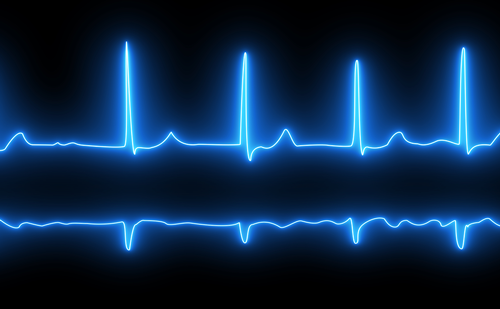Marked prolongation of QRS duration after initiation of dronedarone therapy
Abstract
Overview
Dronedarone is a relatively new antiarrhythmic drug and is held to be less proarrhythmic than comparable compounds,
although its proarrhythmia potential in humans has not been sufficiently evaluated. We describe a so far
unreported dronedarone effect, namely a significant alteration of both the morphology and the duration of the
QRS complex on the electro cardiogram in a 41-year old patient with symptomatic paroxysmal atrial fibrillation.
Keywords
Adverse drug events, Antiarrhythmic drugs, Atrial fibrillation, Dronedarone.
Article Information
Correspondence
Samir M. Said, Otto-von-Guericke University University Hospital, Centre of Internal Medicine Division of Cardiology Leipziger Str. 44 39120 Magdeburg, Germany samir.said@med.ovgu.de
Further Resources

Trending Topic
The Ground-BrEAking Electroporation-based inTervention for Atrial Fibrillation (BEAT-AF) treatment project is an initiative funded by the European Commission from the European Union’s Horizon 2020 research and innovation programme, and managed under the European Health and Digital Executive Agency (grant number 945125).1,2 The study was also partly funded by IHU LIRYC ANR-10-IAHU-04. This pioneering 5-year programme commenced on […]
Related Content in Atrial Fibrillation

Highlights The autonomic nervous system plays a critical role in the aetiopathogenesis of atrial fibrillation (AF). Neuromodulation of the autonomic nervous system has been a topic of increased interest in the management of AF. Ablation of ganglionated plexi, ethanol ablation ...

The landscape of managing atrial fibrillation (AF), the most common cardiac arrhythmia and leading cause of stroke, has undergone a period of change following the development of various treatment modalities and risk-modifying strategies designed to mitigate the risk of stroke ...

Catheter ablation has emerged as an effective strategy for the treatment of atrial fibrillation (AF), even becoming a first-line option for selected patients.1 Pulmonary vein isolation (PVI) is the cornerstone of this procedure. Ablation beyond PVI is often practised, but ...

Heart failure (HF) and atrial fibrillation (AF) are inexorably linked. They frequently coexist and share common risk factors, including ageing, hypertension, diabetes, obesity, sleep apnoea and coronary disease.1–4 Over half of patients with HF develop AF at some point,5 and ...

Welcome to the latest edition of European Journal of Arrhythmia & Electrophysiology. Cardiac arrhythmias, the most common of which is atrial fibrillation, represent a substantial health and economic burden worldwide. In the last two decades we have observed major breakthroughs ...

Atrial fibrillation (AF), one of the most common cardiac arrhythmias, is considered to be a significant risk factor for cardiovascular disease, stroke and mortality. The prevalence of AF increases with age, and patients with AF are at risk of atrial ...

Atrial fibrillation (AF) is the most common type of treated cardiac arrhythmia. The prevalence of the condition increases with age, and it presents with a wide spectrum of symptoms and severity. As the population ages, particularly in developed countries, the ...

Atrial fibrillation (AF) is the most common sustained cardiac arrhythmia and a major cause of morbidity and mortality; however, an optimal strategy for its management remains somewhat unclear, especially for patients with persistent AF.1 Electrical cardioversion (ECV) is widely used ...

As clinicians and academics, we have at least three reasons for developing a simple stepwise algorithm for the management of atrial fibrillation (AF) with rapid ventricular response (RVR) in the emergency department (ED). First, AF is the most common rhythm ...

Atrial fibrillation (AF) is the most common cardiac arrhythmia observed in clinical practice worldwide.1 The incidence of AF is around 0.1% in individuals under 55 years old and 9% in those aged over 80.2 The global prevalence of AF is estimated to be around 44 ...

Atrial fibrillation (AF) and heart failure (HF) often co-exist. The incidence of AF is estimated to reach 45% of patients with HF and rises with the severity of HF symptoms, from about 5% of patients in the New York Heart Association (NYHA) ...

Background: Post-atrial fibrillation (AF) ablation clinics are typically in person, whereby 12-lead electrograms (ECG) and/or Holter monitors can detect recurrence. During the COVID-19 pandemic, at our site, nurse-led clinics were telephonic, and timely access to these investigations became difficult. ...
Latest articles videos and clinical updates - straight to your inbox
Log into your Touch Account
Earn and track your CME credits on the go, save articles for later, and follow the latest congress coverage.
Register now for FREE Access
Register for free to hear about the latest expert-led education, peer-reviewed articles, conference highlights, and innovative CME activities.
Sign up with an Email
Or use a Social Account.
This Functionality is for
Members Only
Explore the latest in medical education and stay current in your field. Create a free account to track your learning.

